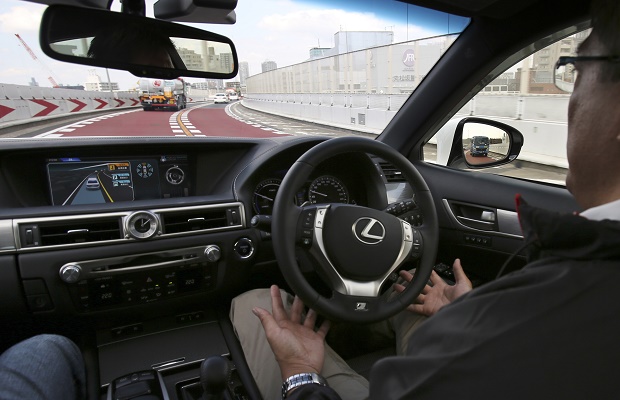
An employee of Toyota Motor Corp., drives automated driving test vehicle during a test drive of Toyota’s self-driving technologies in Tokyo, Tuesday, Oct. 6, 2015. Toyota unveiled its vision for self-driving cars in a challenge to other automakers as well as industry newcomer Google Inc., promising to start selling such vehicles in Japan by 2020. Toyota Motor Corp. demonstrated on a regular Tokyo freeway Tuesday what it called the “mobility teammate concept,” meaning the driver and the artificial intelligence in a sensor-packed car work together as a team. AP Photo
ARLINGTON, Va., United States—Self-driving cars faced what might be their ultimate test Monday: I-95 in northern Virginia.
The Virginia Tech Transportation Institute demonstrated its automated vehicle technology Monday on the I-95 Express Lanes, a stretch of asphalt on the notorious I-95 corridor that connects the traffic-choked suburbs of northern Virginia to the nation’s capital.
Officials at the institute and an administrator at the U.S. Department of Transportation said they believe it’s the first time that driverless technology this advanced has been tested on an actual highway, though they acknowledged that research in the field is evolving quickly and not always easily tracked.
And the demonstration itself was highly controlled: It occurred at midday, when the Express Lanes were otherwise empty, as they were in the midst of the reversal process from northbound for the morning rush hour to southbound for the afternoon rush.
The especially modified Cadillac SRX wasn’t driverless. Virginia law requires a driver behind the wheel, and the technology still requires a driver to be ready to take over if necessary.
But the self-driving car handled lane changes on its own and adjusted speeds to account for simulated traffic and construction zones.
Sen. Mark Warner, D-Virginia, participated as a passenger. His eyes widened when the car slowed on its own as the lead vehicle in the caravan hit its brakes. They widened again when the car shifted lanes with the driver’s hands off the wheel to make way for a police vehicle with its sirens wailing as part of the simulation.
Afterward, Warner admitted to a brief “moment of terror” at the abrupt changes, but predicted that the technology is poised to take off.
“This is the next big, great, disruptive technology,” said Warner, who made his fortune decades ago as a ground-floor investor in mobile phones and helped found what became Nextel. Warner said the similarities between automated vehicle technology and the wireless industry three decades ago are striking.
The test conducted Monday by VTTI involved what is known as Level 3 automated technology, sort of a midpoint between fully automated technology and no automation. VTTI spokeswoman Mindy Buchanan-King said Monday’s test went beyond some of the other technology entering the marketplace because it allowed drivers to not only take their hands off the wheel and their foot off the pedals but also let them take their eyes off the road for extended periods.
Technology debuted last week by Tesla, for instance, allows for automated lane changes and braking, but comes with a warning for the driver to continue paying close attention and keep hands on the wheel.
The Virginia Tech technology contains some unique features, automatically shifting lanes to the right during the simulation when a state police trooper approached with sirens wailing. And the Cadillac automatically slowed as it approached a simulated work zone and traffic stop.
David Taylor, an electronics technician with VTTI, said the test went largely as planned. At one point during a lane shift the car over-shifted slightly, veering to the far right side of the right hand lane, prompting the driver to grab the wheel and take control, but otherwise it went smoothly, Taylor said.
The institute’s director, Tom Dingus, said VTTI has no plans to market or sell its technology. Instead, it serves as a research tool for automakers, the U.S. Department of Transportation and others to help them study and develop their own products.
RELATED STORIES
Google: Driverless cars are mastering city streets
Self-driving Toyota car aims to eliminate road accidents